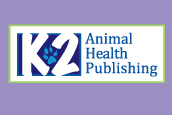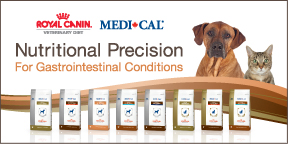
![]()

Physical Therapy Options in the Critical Care Setting
MONTREAL, QC – Physical therapy can be useful to help prevent secondary conditions from arising. Critical or recumbent patients often suffer from secondary illnesses such as atelactasis, pneumonia, thrombosis, and muscle atrophy, explained Kimm Wuestenberg CVT, VTS (ECC, SAIM), speaking at the ACVIM Forum.
Physical therapy, defined as the science of applying biomechanics, physics, anatomy, physiology, and psychology to individuals with dysfunction, injury or pain, enhances the natural healing process and improves surgery or injury recovery time. It also increases blood flow, allows for better lymph drainage, prevents or reduces muscle atrophy and reduces pain. Ms. Wuestenberg said that in the recumbent patient, thoracic physical therapy helps improve breathing, thus increasing oxygen levels in systemic circulation. In addition, physical therapy is a non-invasive treatment, is generally low cost, and has psychological benefits for the patient. The main forethought in performing physical therapy, she added, is having an accurate understanding of the nature of the injury and the mechanism(s) involved in recovery.
Common interventions in the ICU/CCU setting
Useful techniques include massage, active and passive range of motion (ROM, PROM), thermal agents, positioning, postural drainage, percussion, vibration, and low level lasers. Physical therapy can be performed every four to eight hours depending on the patients’ needs. Ms. Wuestenberg explained that massage and ROM exercises can help circulation, reducing the risk for thrombosis while ROM exercises will help prevent or reduce muscle atrophy. Thermal agents include the application of heat and/or ice; heat dilates the capillaries and allows for better blood flow to the region and ice causes vasoconstriction, reducing swelling and inflammation. Furthermore, she said, both of these thermal agents contribute to pain management. Positional changes help to prevent decubital ulcers, atelactasis, and peripheral edema. For ICU patients who are unable to productively cough, postural drainage, percussion, and vibration should be implemented. This may help prevent an accumulation of respiratory secretions which can lead to conditions such as pneumonia.
Overview of physical therapy techniques
Massage therapy relaxes the patient and aids in pain relief. There are two main massage techniques used in a critical care setting — effleurage and pettrissage. Pettrissage involves a squeezing and kneading technique while effleurage involves strokes; both techniques improve circulation, thus should be performed distal to proximal on the extremities.
Rehabilitation exercises such as ROM and PROM are used in the ICU to improve circulation and prevent peripheral edema in addition to preventing muscle atrophy. The extremities should be flexed and extended prior to ROM exercises. Ms. Wuestenberg said that in passive ROM, the veterinary personnel are moving the extremities and the joint in a slow cycling motion, while active ROM involves the patient actively moving and resisting. She recommended that several sets be performed two to three times daily with care being taken to not overexert the patient.
Thermal agents will provide analgesia and reduce inflammation. The application of cold packs is typically used every four to six hours within the first 24 to 48 hours of injury or surgery. After the initial 24-48 hour period, heat is then used at the same interval schedule. She cautioned that a towel should be placed between the agent and the patient to prevent burns when heat and cold applications are used. Thermal agents can be applied for 5 to 15 minutes at each session.
Positional changes involve moving a patient from right lateral, sternal and left lateral recumbency throughout the hospital stay. Decubital ulcers, pneumonia and atelactasis may ensue if the patient is not moved for a significant period of time. Adequate blankets, pillows, cushions, and mattresses should be used in the recumbent patient to aid in positioning and preventing pressure sores.
Thoracic physical therapy, or chest physiotherapy (CPT), includes postural drainage, percussion, and vibration. Other treatments which may be used in conjunction with thoracic physical therapy include nebulization and suctioning of secretions. Ms. Wuestenberg explained that percussion, or coupage, helps to break up secretions and is performed by cupping the hands and gently impacting the thorax during inhalation and exhalation. Vibration can then be performed to help further break up secretions and move them toward the larger airways. Vibration is performed on exhalation and involves rapidly moving hands in a tapping motion over specific areas of the chest. Vibration is less forceful than percussion and may be used in place of percussion in patients with rib injuries. Postural drainage uses gravity to drain secretions in the lungs and into the main airway and also relieves pressure in cases of atelactasis. These secretions can either be suctioned out or, if able, the patient may cough the secretions out of the airway. Assisted coughing may be required if the patient is unable to remove mucus from the airway, and should be performed with the patient in sternal recumbency. It can be induced by gently palpating the trachea. A manoeuvre (similar to the Heimlich manoeuvre) where pressure is placed on the cranial abdomen, thrusting cranially on exhalation, may also aid in coughing up secretions.
Postural drainage is not without risks, cautioned Ms. Wuestenberg. There can be significant side effects such as oxygen deficiency, increased intracranial pressure, decreased blood pressure, bleeding into the lungs, pain, vomiting (+/- aspiration), and injury to the spinal cord. In human studies, cardiac arrhythmias have been noted during postural drainage and percussion of ICU patients. Human precaution guidelines include patients with neck or head injuries, active hemorrhage or bleeding from the lungs, fractured ribs, recent surgeries, open wounds, burns, and pulmonary embolism. Veterinary precautions published include coagulopathies and cardiac disease in addition to the aforementioned conditions. During postural drainage, patients are placed in specific positions for up to fifteen minutes, with recumbent patients receiving drainage therapy every six to eight hours. The goal of thoracic physical therapy is to ensure the patient is able to breathe adequate amounts of oxygen and remove sputum secretions from the lungs. Arterial blood gases may be performed to monitor the results of thoracic physical therapy as well as manual auscultation and assessment of lung sound changes.
Ms. Wuestenberg said that in the last decade, red beam or near infrared laser therapy has become more popular in North America. Laser therapy uses light and heat from a laser to activate cells and stimulate tissue repair and growth, improving circulation and healing
and reducing pain and inflammation. She said that laser therapy can particularly help
with musculoskeletal and neurological conditions, soft tissue injuries, and wound healing.
CVT
Postural Drainage Techniques
| Position | Action Focal Point |
| Left lateral recumbency with hind end elevated 40° | Lateral segment of left caudal lung lobe; lateral segment of right caudal lung lobe |
| Sternal recumbency with hind end elevated 40° | Left & right caudal dorsal lung fields |
| Dorsal recumbency with hind end elevated 40° | Left & right caudal ventral lung fields |
| Dorsal recumbency with hind end elevated 40°, front end rotated ¼ turn to the right with a pillow under the right side of thorax |
Right middle lung lobe |
| Sternal recumbency with front end elevated 40° | Left & right cranial dorsal lung fields |
| Dorsal recumbency with front end elevated 40° | Left & right cranial ventral lung fields |
Potential Physiotherapy Interventions
| ICU Specific Conditions | Physical Therapy Applications |
| Neurological ie: Spinal cord injury, paralysis, paresis |
Positioning, PROM, Massage, Postural Drainage +/- percussion & vibration |
| Soft Tissue ie: Muscle atrophy, wound care, edema, inflammation |
Positioning, laser, PROM, massage, ice |
| Respiratory: ie: Pneumonia, atelactasis, mechanical ventilation |
PROM, massage, percussion, vibration, postural drainage |



